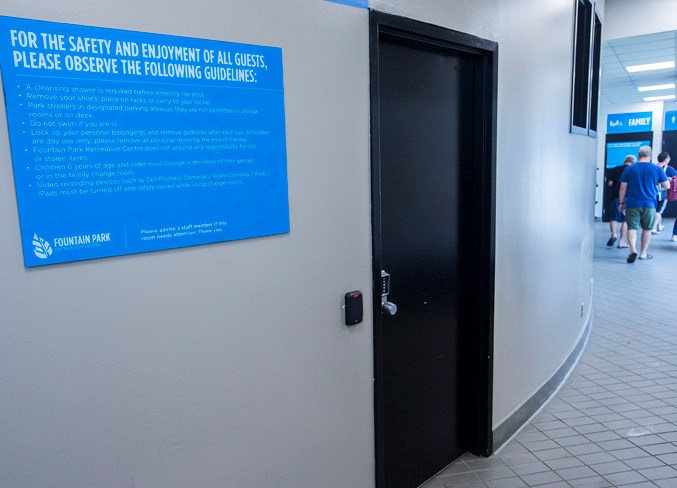Patrons frequenting Fountain Park Recreation Centre are having a heated debate about the age limit for children using an opposite-gender change room. The current age is five years old.
However, Shaun Percival, manager of aquatic services at the centre, said he has a hard time seeing any changes coming in the near future.
“The decision to maintain this particular age … is based on the idea of mitigating risk in an otherwise risky environment,” Percival said in a recent interview.
Risks young children might encounter alone in a change room could include the inability to: change appropriately, remembering the locker combination and using the lock and/or shower properly before entering the pool (a requirement of the facility). There is also the serious risk of potential sexualization.
Fountain Park Recreation Centre gets a lot of foot traffic from a large demographic. Percival said the facility sees about 1,000 patrons daily.
“We obviously don't want anyone left to feel uncomfortable in the change room, and the door swings both ways on that.”
Two sides of the coin
Much of the debate has taken place in recent Gazette letters to the editor. Some people argue pools should bring the current age limit of five years old down to three.Carol Gallagher was the first to voice a growing concern over older boys in the women’s change room. Gallagher and others said they feel uncomfortable when boys stare at their naked bodies. They prefer to shower nude and then get dressed in a stall. However, there are no privacy screens in the showers and crowded conditions sometimes make it difficult to find an empty stall.
On the other side, Sheena Fulton (Gazette, July 28) said family change rooms are a modern invention and people got along fine in the past without them. She argued small children need their parents’ assistance and sometimes their protection.
In total, the ladies’ change room has seven changing stalls with doors. The family room has six stalls and the men’s room has none.
Current change-room rules
Percival said Fountain Park staff direct families with more than two members to the family change rooms. Otherwise, a caregiver with a single child aged five and under is allowed to use the gendered change room of the caregiver. He said the current age restriction of five has been an industry standard for as long as he can remember.Percival meets with other aquatic managers in the capital region on a quarterly basis to discuss emergent issues. He said the age limit of children in opposite-gender change rooms has been a small-scale discussion point. Instead, current discussions are geared towards the potential of universal changing rooms.
For instance, Harbour Pool in Fort Saskatchewan is now building a unique and inclusive gender-neutral change area.
“Quite a few people come to the facility with special needs, and they are of opposite sex so they can’t go into the change room together to change. That was one of the major pushes,” said Kayla Dow, aquatic operations supervisor of the Fort Saskatchewan pool.
The universal change room is for people who require assistance changing or have accessibility needs. It’s also for families with older children or for people who require a gender-neutral change area. Dow said she’s hoping the room will be open by Feb. 1, 2019.
Fountain Park pool is limited by its existing structure. But Percival said universal change rooms are a possibility; he added he’s open to discussion on emerging trends and changes in the industry.
“We have to keep our finger on the pulse of society as it changes.”
Changing definitions
Age and gender can be considered social constructs. Their meanings differ based on the society and events surrounding the time period in which they exist. In other words, as times change, people’s views of age and gender change as well.Current change-room rules reflect a time when children under six don’t exactly fall on the man versus woman spectrum. Rather, they are somewhere in between. Thus, it is considered acceptable for young boys and girls to enter opposite-gender change rooms because they are still learning about bodies and gender roles.
Joanne Minaker, associate professor in MacEwan University’s sociology department, said people should consider other contexts about what is/is not appropriate for children and what the societal expectations of good parenting are. Would we expect mothers in the change rooms to act differently in other situations?
“Say, being alone at home, going to the park unaccompanied, being on their own on public transportation, and ask ourselves: ‘Are the concerns raised here in the editorials consistent or inconsistent with other social and cultural norms?‘”
Minaker said she looks at gendered spaces and the alternatives. She added having more than one designated family room could provide a non-gendered alternative for caring adults to change elsewhere.
The title of one letter to the editor stood out to Minaker. It read: We must respect women who don’t want to be seen naked in change rooms.
“It occurs to me that the period should be after women. Or, better, the word replaced with people. It’s about respect.”




